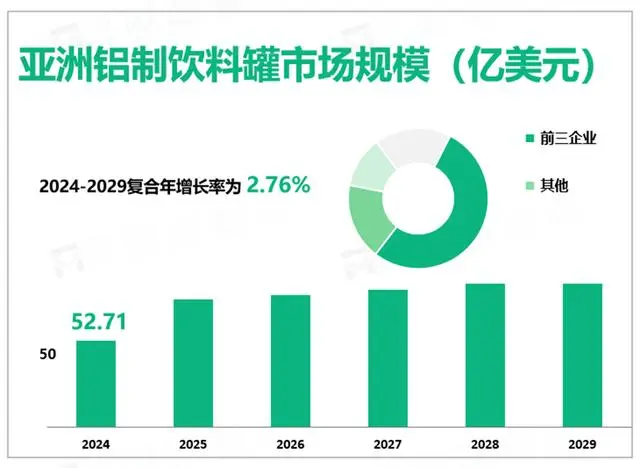Market Overview of Aluminum Beverage Can Industry in Asia
According to Betzers Consulting, the market size of the aluminum beverage can industry in Asia is $5.271 billion in 2024, with a compound annual growth rate of 2.76% from 2024 to 2029.
Aluminum beverage cans are valued for their convenience and portability. Aluminum cans can also effectively block light and oxygen, which can affect the flavor and freshness of beverages. In addition, aluminum beverage cans cool faster than other materials, so customers can enjoy their beverages faster.
Some potential problems with aluminum cans may hinder market development
Aluminum can manufacturers line the cans with a thin layer of plastic to prevent aluminum from seeping into food. But one side effect of adding plastic linings to aluminum cans is that consumers may be exposed to toxic substances beyond the safe range. In addition, when people open the aluminum can, the inside will cause injuries due to its sharp edges, which is a risk that other types of food packaging materials do not have. Injuries caused by opening aluminum cans may require sutures, sterile dressings and antibiotics, and this risk affects children as well as adults.
Selling beverages in aluminum cans and avoiding plastics is a trend in Asia, but aluminum cans are not without harm. Aluminum cans are not entirely environmentally friendly. The production of aluminum consumes a lot of electricity and also produces some greenhouse gas chemical emissions. Smelting aluminum emits greenhouse gases and toxins, including carbon dioxide, fluoride, sulfur dioxide, dust, polycyclic aromatic hydrocarbons and toxic wastewater.
Market size of aluminum beverage can industry in Asia

Market drivers of aluminum beverage cans
In recent years, there has been a wave of negative publicity and consumer backlash against single-use plastic products, especially plastic bottles. The image of bottles overflowing landfills and adversely affecting the ecosystem makes consumers uncomfortable. Since aluminum cans have higher recycling rates and more recycled content than competing products, they are gradually being seen as the best alternative.
More and more Asian countries and companies are using practical actions to show their concern for environmental protection. For example, in India, Hindalco Industries Limited, Ball Beverage Packaging (India) and Can-Pack India jointly established India's first aluminum beverage can association, called Aluminum Beverages Can Association Of India-'ABCAI'; in Vietnam, beverage company Winking Seal Bia Co., TBC-Ball Vietnam Beverage Co., Ltd. and Ball Asia Pacific Co., Ltd. jointly launched bottled water product beWater, which is packaged in aluminum cans. Therefore, in Asia, the deepening awareness of the dangers of plastic products is one of the important driving forces.
Market Opportunities for Aluminum Beverage Cans
Japan and Southeast Asia are the two regions with the largest market share of aluminum cans. Japan has advanced environmental awareness and attaches great importance to environmental protection. The recycling rate of aluminum cans has always been at the forefront of the world. However, due to the aging population in Japan and the pressure of the cost of using aluminum cans, downstream demand has declined. Therefore, in recent years, the sales volume of aluminum cans in Japan has been on a downward trend, and some companies have had to reduce the production of aluminum cans (such as Showa Denko), resulting in a decline in market share. On the contrary, the market share in Southeast Asia is increasing due to the increase in investment by multinational companies. With economic development and population growth, the region is expected to become the next growth market, bringing opportunities to the market. Second, India's current market share is small, but the emergence of a ban on disposable plastics has become a policy support for aluminum cans, which forces companies that want to enter the Indian market to develop in a more appropriate direction. Therefore, India's future aluminum can market has great potential.
| Southeast Asia | Major market |
| South Korea | Relatively small market |
| Japan | Major market |
| India | Market with development potential |